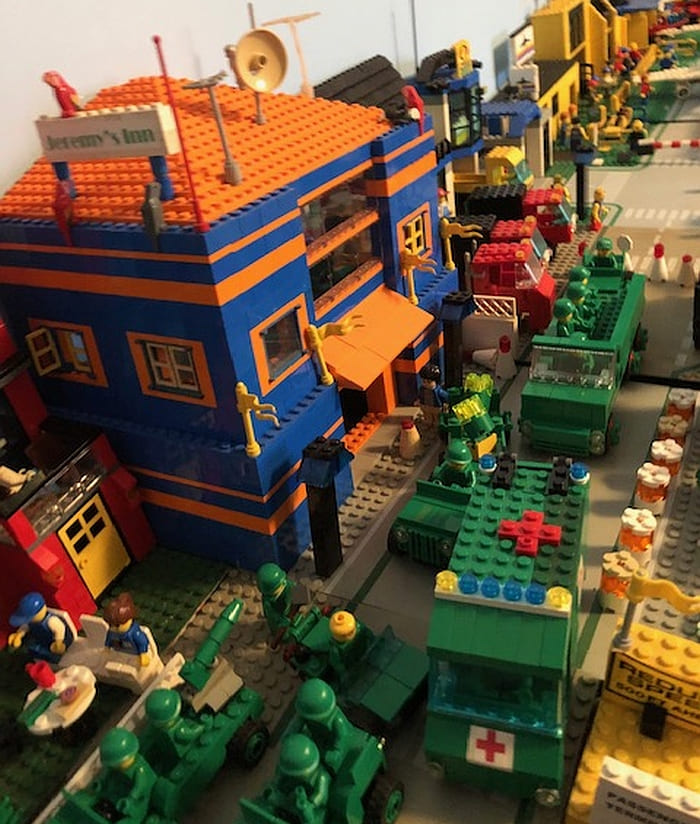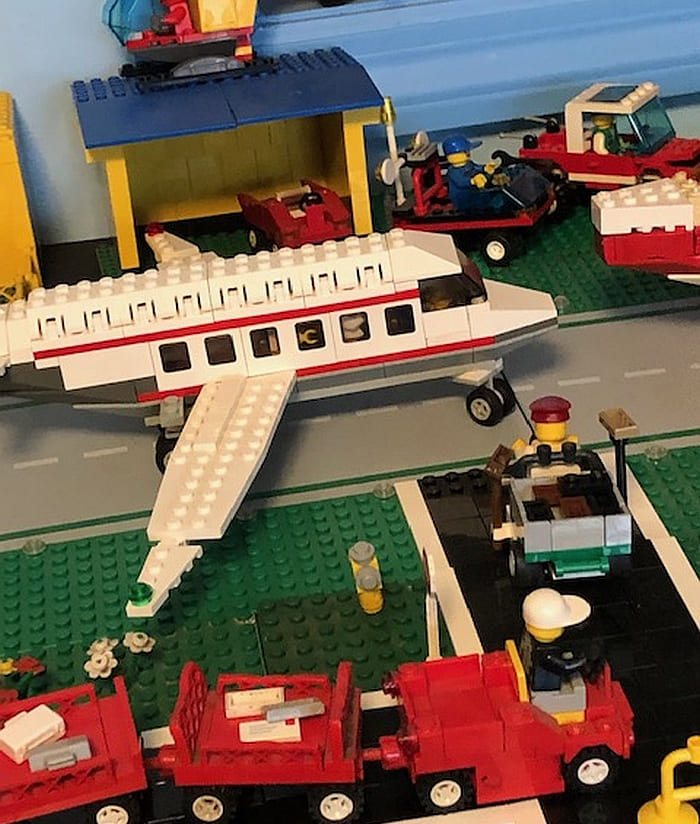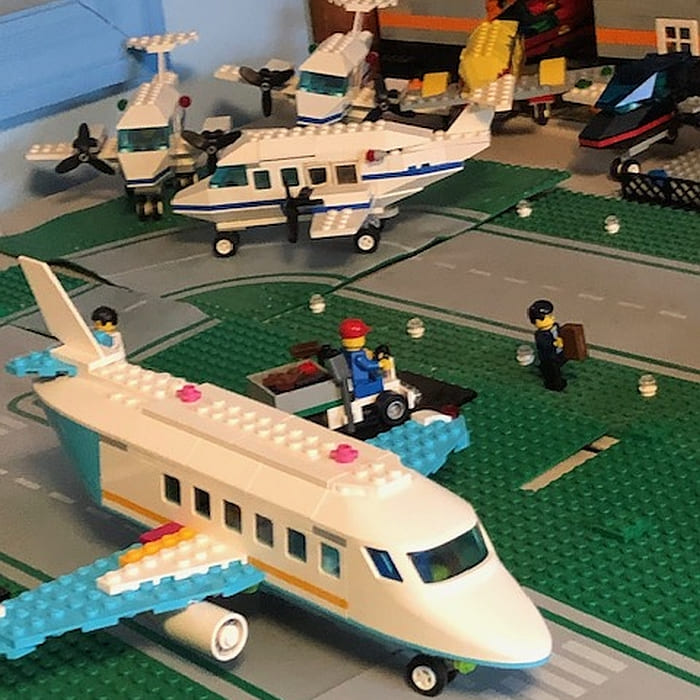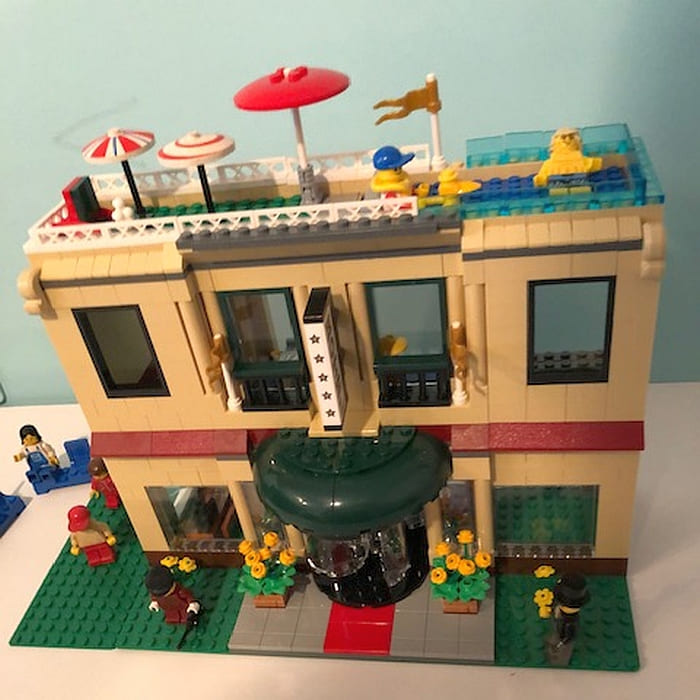(Written by Mark H. Avery)
This is a continuation from my previous article, Learning from Model Train Magazines – Part 1. If you read that essay, you know that I enjoy getting ideas for my LEGO city layout and buildings from hobby train magazines and catalogs. Today, we will discuss the topic further, especially the importance of observing the world around you to make your LEGO city as realistic as possible.

LEGO CITY PLANNING – MAKE A SCENE
I think my message is fairly obvious: details make a difference. Railroad Model Craftsman Magazine (December, 2003) illustrated five scenes: country, farm, residential, commercial, and industrial before and after the details were added. Each case is different, but as the magazine pointed out, “…adding details gives them modeling character and brings the scenes alive” (page 85). “You can start from photos you have taken or seen in books and articles, scenes from your memory, or written descriptions. … you are building a three-dimensional snapshot of that reality.”

The LEGO Company sells lots of buildings. Our job is often to take those buildings and turn them into scenes. Then we need to bring those scenes to life (Classic Toy Trains Magazine, November 2011).
The small things matter. Try incorporating several mini-scenes in your LEGO layout. How about a billboard with half a sign and a man on a ladder hanging the rest? [I saw that in an advertisement for Woodland Scenics.] Some modern billboards are two-sided and built like the letter V on its side. A group of people in front of a newsstand (remember those?) is a mini-scene. So is a group (and maybe some cars) by a produce stand (Classic Toy Train Magazine, March 2005). A window washer working by a store is a mini-scene. So is one hanging from a scaffold (O Gauge Railroading Magazine, December 2006).
Modelers would consider it a major error to have a car driving down the street without a driver (a small car might sometimes require a legless minifigure, but even that is better than not having a driver). Whether you build your roads out of bricks, tiles, or LEGO road-plates, they are not supposed to be shiny. Some rail modelers even put crack lines (drawn with a Sharpie), or oils spills on their roads.
If you have a stretch of highway, consider a truck weigh station off to the side. A shack and a sign is all it takes (Model Railroader Magazine, August 2010 has a ‘new product listing’).
Graffiti, anybody? Personally, I wouldn’t do it, but adding graffiti to walls, trucks, and freight trains is one way to make a layout look more realistic. You can even purchase graffiti decals.
In a previous essay, I discussed signage. Since then, I came across an educational article about “hazardous material markings” – little signs that get hung on trucks and rail cars (Model Railroader Magazine, May 2009). There are nine different categories of such signs! For example, compressed gas has a different sign for flammable and non-flammable. Both these markings and traffic signage are discussed in detail on Federal Government websites.
Windows are a key part of any building. Consider fogging the windows with tissue paper. Or use tiny bits of colored construction paper to make window shades and curtains. In one house, different shades are pulled down to different points.
LEGO CITY PLANNING – BUILDINGS
LEGO structures can and should be personalized (Model Railroader Magazine, June 2003). Switch one of the colors in a set. You can even use two of the same set if they are in different colors. (I often try to get rid of one of the loud colors from LEGO Friends sets.) Stores can be used for different uses than originally intended. Insides of the buildings don’t have to be detailed (I typically don’t detail them). But it helps if they do appear to be detailed. For stores, this might mean merchandise or signs in the windows, and maybe someone walking in or out of the store (Model Railroader Magazine, July 1996 – that’s before I was born!). has a great article about ‘individualizing kit structures’. The author takes a Western Union office kit and shows how it can be easily adjusted to alternatively make a garage and a little mechanical shop. For example, I took a #31065 LEGO Creator Park Street Townhouse and built it in a different color out of spare bricks, modifying for missing unique pieces, and adding an extra floor for good measure.

I think every LEGO building ever sold is much too shallow for its width (Model Railroader Magazine, December 2019). A typical store that is one baseplate wide (10 inches) should probably be at least three baseplates (30 inches) deep. In my real-life neighborhood, typical houses are built on 20 x 100 lots, a ratio of one to five. Frontage on a commercial street is what a storekeeper pays for, and sometimes what tax rates are based on. This proportionality issue even applies to the LEGO Modular Buildings. You certainly can’t fix it all, but sometimes a back wall can be made into two expanded side walls and the back left open or closed with nondescript bricks.
LEGO CITY PLANNING – PUTTING TOGETHER A CITY
Does your layout represent New York City, or Oshkosh, or a tiny town like Bentlyville, PA? It makes a difference.

In most places, the most expensive land values are at the center of town. That’s why the tallest buildings are located there. But that’s also the origins of the town, so the oldest buildings are there as well. If you have dates on your buildings, as do some of the LEGO Modular Buildings, that’s an important point. In all cases, the key is that the buildings logically belong. Putting a gasoline station or farm in the heart of downtown Boston doesn’t make sense. Neither does building a skyscraper in the boondocks, where land is cheap.
Just about every small town started with a church, usually in the center of town, and typically on the highest point in the village. I don’t recall an official LEGO church. Older towns all had post offices in town. More recently, some have moved to strip malls. You have a 5 & 10 store in town? You are dating your layout. On the other hand, a dollar store would fit most towns nicely. Most towns also had saloons among their original buildings. I understand why LEGO hasn’t made a bar, but that doesn’t mean you can’t make your own.
Most model railroads seem to depict smallish towns with countryside in between. So when I find an urban layout, I pay special attention. One such example is “the Beer Line” a Model Railroader Magazine project that ran from January to May 2009. The April issue focused on buildings, including the Schlitz Beer brewing facility. Rod Stewart, the rock ‘n’ roller, has a huge urban HO layout (illustrated in MR December 2019, and again much earlier). It illustrates a large big city downtown with a harbor.
Want to model a small town? “Building Eureka” in the MR January and February 2009 issues might give you some ideas. So might “How to Build a Small Railroad Town” in the July 2009 issue. Neil Schoor is a master train builder of the Pennsylvania Railroad and a good writer. He took a deep corner of his layout and illustrates step-by-step how he built the town of Duncannon (CTT, February 2016). He explains how he picked and modified buildings, how he designed roads, and how he added detailing such as fire hydrants, mailboxes, and parking meters. A train underpass is tangent to the town. There are several more examples in recent issues, which are still for sale. Another article (O Gauge Railroading, August 2001) takes a block of buildings and goes into details of how to organize them. The MR March 2013 issue brings together several useful articles: creating a town square with a statue, adding background buildings and roads that disappear between them, using mundane urban structures that don’t stand out, changing around and modernizing a small town, and how to integrate different buildings so they belong together.
There are also examples of small freight switching layouts which have factories, warehouses and lots of train tracks, but typically no houses or stores. Remember, I’m not looking at “how” to build, because my medium is different, LEGO. Also know that some modeling kits may be available for decades, while most LEGO sets disappear from the shelf after two years.

Your layout has a small airport? Shouldn’t there a motel nearby? A simple three-story one you could mimic comes from Pikesville Models (CTT, November 2016). I built the admittedly small hotel from the #60200 LEGO Capital City set and added matching wings on each side. I also have the old #10041 LEGO Main Street hotel greatly expanded in height and width from the original, and my own Jeremy’s Inn with an orange roof like the old Howard Johnsons. Airport parking, a car rental lot and shack, and airport service facilities all add to the story. Given today’s issues of security, I also have several army jeeps (from the original LEGO Toy Story series) stationed by the airport entrance. Also consider having a few airplanes or helicopters hanging from the ceiling.
LEGO has made several house and camping trailers over the years. You can have one on a road or parked in a driveway. I have several clustered together in a park overlooking the river. Bob Bennett (MR, September 2017) has three pages of suggestions. A little porch, a picnic bench, a nearby storage shed with junk (an old ladder, some spare tires, etc.) behind it, a barbeque, a garbage can or dumpster, a tiny bird house, and a clothes line all make it a complete scene. A fence helps separate this scene from others.
Consider a farm. Some green baseplates, as much greenery as you want, and some cows make a pasture. (I use about a dozen O-scale cows – LEGO ones are just too expensive for my taste.) Add a watering hole and fencing. Have more space? Add a pigpen and chicken coop. Add a barn and tractor. Some farmers and horses all add to the story. (At one time shipping cows and pigs to market – often Chicago – was a major business for the railroads.)
LEGO CITY PLANNING – LEISURE TIME ACTIVITIES
Minifigures need a place to relax and have some fun. There are model railroads with miniature golf courses. A few with small sandlot baseball diamonds. One or two with basketball courts. Playgrounds for kids show up both in model railroads and in LEGO. Swimming pools are fairly common (I have a rooftop one), especially in LEGO Friends sets. My current layout features a zoo, a fairly large racetrack incorporating the original #6395 LEGO Victory Lap Speedway from 1988 and several racing sets since. I also have a soccer field (#3409 LEGO Championship Challenge) with many of its auxiliary sets. Don’t ignore small scenes. For example, toy train models exist for pony rides, log-sawing competitions, tug-of-war competitions (CTT, May 2017) and circuses, not to mention long circus trains. A very old LEGO Idea Book illustrates a circus and included circus stickers.

Amusement parks, kiddy rides, theme parks, and county fairs are all different, but all have common characteristics and might be combined in a LEGO exhibit. Many LEGO city layouts now have amusement parks, taking advantage of the spectacular LEGO rides that come out each year. But there are lots of smaller rides you can buy or create on your own.
While LEGO produces sets with Disney licenses, the two companies are somewhat of competitors in the theme park business, obviously on different scales. Perhaps a neutral name and identification is useful for your park. The theme park concept seems the broadest. Look, for example, at YouTube videos put out by Dr. McBrick. He got a few LEGO Castle sets and they now form the opening area of his park, ‘Six Figs’. He’s taken sets from the old LEGO Desert Adventurers series to create another themed area. He adapted the #31084 LEGO Pirate Roller Coaster and the new #21322 LEGO Ideas Barracuda Bay pirate ship and he has a pirate area. (I still have the original #6285 LEGO Black Seas Barracuda from 1990 on display.) His brilliance is how he ties it all together. But he also seems to have endless table space, and maybe lots of money.
My next big project is going to be a theme park, hopefully documented on this blog. So I won’t spend that much time talking about it here. But I would think that just about every LEGO townie has gone off the path and purchased some non-town sets. Even I, who have never seen the movies, have a few small original LEGO Star Wars sets. A theme park is the chance to recycle those sets.
For example, one could take old or new LEGO Harry Potter sets that would never fit into a town setting and use them as a themed area in an amusement park. I intend to dig out my old Harry Potter castle and use it where others use the Disney Castle. Maybe I’ll add some of my other Harry Potter sets as well. Some old Sponge Bob sets can be another theme. So could Minecraft or LEGO Space or Star Wars sets from any era. For example, take a few little spaceships, connect them with 1×10 plates to a small turntable and you have a kiddy ride. Add a few hinge-plates and the spaceships can rise. Alternatively, they can be a display that tourists walk around. For several years, LEGO issued superhero mini-sets of two cars each. They can be connected with a turntable for a kiddy ride, or put on a small track for a ride for older guests. An inexpensive way to make a ride!
The #60234 LEGO City Fun Fair People Pack is the obvious choice for the park, as are LEGO Disney minifigures. But you can add Sponge Bob characters and lots of superhero minifigures to wander through the park and pose for pictures. Here’s a great way to use them!
LEGO CITY PLANNING – THE OLD WEST
The #71044 LEGO Disney Train & Station is a very attractive and popular recent set that many are using. But there are alternatives. The easiest is just to turn a flatbed car into an open observation car. How about the train from the #79111 LEGO Lone Ranger Constitution Train Chase? It wasn’t successful when issued, but is now expensive on the resale market. But if you have it, consider buying or building a rough replica of the #6769 LEGO Western Fort Legorado. Maybe do the same for the #6761 LEGO Western Bandits’ Secret Hide-Out and one or two other buildings of that era ( #6765 LEGO Western Gold City Junction and #6755 LEGO Western Sheriff’s Lock-Up). They aren’t difficult to recreate. Look for WildWestModels.com for some non-LEGO ideas.

The #4438 LEGO City Forest Police Robbers’ Hideout, the #79110 LEGO Lone Ranger Silver Mine Shootout, or some concoction of these gives another attraction. Just be sure to allow a path for visitors to walk through. Add the Lone Ranger train and maybe the #79108 LEGO Lone Ranger Stagecoach Escape and you have a Western themed amusement park or Western themed section of a bigger park. Give the LEGO City Forest Police some horses instead of cars, add a few inexpensive minifigures in cowboy hats, and you’re in business. Remember, I’m not advocating major expenses, but using what you have on hand. Brown 1×2 log bricks are readily available and great for building Western style log walls.
LEGO CITY PLANNING – CONCLUSION
I hope you have enjoyed reading and have hopefully picked up a few ideas for your own LEGO layout. Master train layout builder John Allen suggested (MR, January 1989, page 130) that layouts should be thought of as art, and the layout builder like a realist painter “whose aim is to capture the way actual objects and scenes appear to the viewer…” but also to “improve on nature by selecting appealing subjects… and then combining and arranging them to strengthen the final effect”. And you thought you were just playing with a toy! Your comments and ideas are welcome. Next time, I will mainly explore ideas related to LEGO trains. Happy Building!
And you might also like to check out some of my previous articles:












I like your idea of making themed sections under the excuse of a theme park. Another thing that’s important to plan out is the location of the roads. Like in a real city, it can get really messy if the roads aren’t planned out.
Also, Lego roads tend to be placed out in a rather limited square grid pattern, to begin with. It’s relatively inflexible, unless you’d try out custom attempts, by painted plywood, or possibly the highly part-intensive technique of brick-built roads…
If I had room, I’d like to try a road with two lanes in each direction. I’m also considering the triangle shaped 2×2 tiles to make a road that cuts across at an angle.
Oh, yeah. I reckon that might also be quite part-intensive, and/ or require some engineering feat planning beforehand…
Hmm, there’s also the ramp plates from 6600 and 7994, although they often seem to be quite expensive at Bricklink…
By the way, this is a pretty illustrative images of how the various road plates fit together.
(I guess the “generations” might overlap somewhat, but this is how I interpret it.)
Gen. 1 1978-1985
Gen. 2 1986-1996
Gen. 3 1997-2001
Gen. 4 2002-2004
Gen. 5 2005-today
http://www.suave.net/~dave/images/tmp/road_plate_comp.png
1 2 4
3 5 1
2 4 3
Oh, that’s a very helpful image! Thanks for sharing! 🙂
Courtesy of Dave Eaton, apparently…
I have to pick myself up one of these train magazines. The information sounds interesting. And you also made me interested in train shows in one of your previous articles.
I’d probably suggest Classic Toy Trains.
Thanks, I will check it out.
Vegetation is another thing you have to plan out. Trees, flower beds, vines growing up on the side of buildings. All of these add character and also suggest the season. If you want, you can even change them out seasonally. Autumn leaves for the fall, white pieces for winter, and green leaves and colored flowers for the spring and summer.
Great idea!
I like the tree with the Expert Builder Bookstore. What would it take to build 10 or 20 of them?
I know that the long pieces to make the treetrunk are available in brown, so you could even make the same tree in different colors. The pieces are common and aren’t very expensive.
Mark’s imagination is matched only by his willingness to make his abstractions very real. He explains the details very well. I am sure he will entertain you as much as he entertains himself in order to escape his humdrum day job.
Hal Wicke
So many excellent tips! Graffiti decals – who knew?
Keep the advice coming in your comprehensive and thoughtful articles.
Eclipsegrafx.com carries printed graffiti bricks. Admin wrote about them before.
This is a great list overall. It gives me lots to think about. The one thing I do differently is that I always pay attention to and fully develop interiors. I find it very satisfying to work on interior details like furniture, store fixtures, and alike. True, I’m the only one who knows they are there, but it makes the city more realistic.
Have you considered big “picture windows” so others can see into some of your buildings?
No, I haven’t thought of that, as I’m normally the only one looking at my builds. Sometimes friends and family will check them out, but then I can just take off the floors to show the insides. I like your idea though and will think about it. Thanks for the suggestion.
Hmmm, that curve road plate with the airplanes doesn’t look too happy… Is that something saved from the fire?…
Yes. I should replace it, but I need to find a roadplate from the same era. In general, my airport (like everything else) is too crowded.
I’d assume they’d be easily found on BrickLink, though their price excluding postage might be a bit high.
I got a bunch of road plates now from second hand bulk sales, myself, although I’m actually not sure on where in my apartment I would have space to build up a city. Since I mostly own the earlier generations roadplates (1978-2001), that’s what I prefer, since they’re so difficult to combine with the newer generations.
(If I’d find some newer roadplates in some other second hand bulk I’d buy, I’d probably give them away to my nephew or my nieces or something…)
Obviously, Mark is a very talented and creative Lego-er. Who knew that Lego is an art form?
Love reading the blog and looking at the pictures!
Keep ’em coming!
Great article in the series.
My father was an avid Lego collector and built a whole city that all the kids (let be real, even the adults) loved to come see. My father loved building in the details to make it a real city. He also loved to buy multiples of the same sets and repurpose the second or even third set into something different.
Keep the articles coming. I’m getting a lot of great ideas from them!